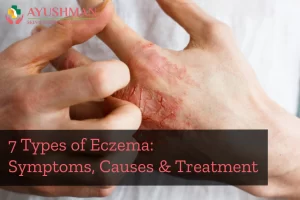Eczema is a common skin condition causing itchiness, rashes, dry patches, and infection. Atopic dermatitis, the most prevalent form, is linked to allergies like asthma and hay fever. Managing eczema involves treatment and avoiding irritants. With over 31 million Americans affected, flare-ups can last days or weeks, worsening with scratching.
Table of Contents
ToggleWhat are the types of eczema?
1. Atopic dermatitis
Atopic dermatitis, the most prevalent form of eczema, typically begins in early childhood, often between the ages of 2 months and 5 years, and tends to improve with age, though flare-ups or new symptoms can still occur later in life.
Symptoms
Atopic dermatitis usually manifests on areas such as the arms, elbows, and knees, with infants often experiencing it on their scalp and cheeks. To minimize the risk of infection, it’s essential to avoid scratching.
Causes
While the precise cause of atopic dermatitis is not fully understood, it generally occurs when the skin’s protective barrier becomes compromised, making it less effective at shielding against irritants and allergens. The condition is thought to result from a combination of factors, including:
- Genetic susceptibility
- Dry skin
- Immune system abnormalities
- Triggers like irritants, stress, and environmental dryness
2. Contact Dermatitis
Contact dermatitis is primarily categorized into two types:
- Allergic Contact Dermatitis: This type occurs when your immune system reacts excessively to substances such as latex or certain metals.
- Irritant Contact Dermatitis: This form arises when a chemical or other substance directly damages your skin.
Symptoms
Symptoms of contact dermatitis may not appear until up to 48 hours after exposure to the triggering substance. If you have contact dermatitis, you might experience:
- Itchy skin may turn red, pink, or magenta; in darker skin tones, it could appear brown, purple, or gray.
- The feeling of burning or tingling on the skin.
- Hives.
- Fluid-filled blisters.
- Skin that becomes thickened and leathery
Causes
Contact dermatitis results from your skin reacting to an irritant or allergen that you come into contact with. Common irritants include:
- Detergents, Bleach, Jewelry, Latex, Nickel, Paint, Poison ivy and other toxic plants, Skincare products and cosmetics, Soaps and perfumes, Solvents, Tobacco smoke
3. Dyshidrotic eczema
Dyshidrotic eczema, or pompholyx, leads to the development of tiny blisters on the hands and feet.
Symptoms
Symptoms of dyshidrotic eczema can persist for 2 to 3 weeks. You might observe fluid-filled blisters that are itchy, painful, and prone to cracking or peeling. These blisters typically appear on:
- Fingers
- Toes
- Palms of the hands
- Soles of the feet
Causes
Dyshidrotic eczema can be triggered by several factors, including:
- Allergies
- Excess moisture on the hands and feet
- Exposure to metals such as nickel, cobalt, or chromium compounds
- Stress
- Tobacco smoking
4. Seborrheic dermatitis
Seborrheic dermatitis, commonly called scalp eczema, mainly impacts the scalp. In infants, it’s known as cradle cap and usually clears up on its own without returning. In teenagers and adults, seborrheic dermatitis often develops into a persistent issue.
Symptoms
Seborrheic dermatitis can result in scaly, oily patches that shed dandruff-like flakes. These patches usually appear in areas rich in oil glands, including:
- The scalp
- The hairline
- The upper back
- The nose
- The groin
On darker skin tones, the patches may look darker, while on lighter skin, they might appear lighter.
Causes
Seborrheic dermatitis often arises from a combination of environmental and genetic factors. The typical progression includes:
- Trigger Event: Stress, illness, or other factors provoke an inflammatory response in the skin.
- Overactive Oil Glands: This inflammation prompts the oil glands to produce more oil, fostering the growth of Malassezia yeast, which is normally present on the skin.
- Immune Response: When the yeast overgrows, the immune system reacts, resulting in the distinctive skin changes associated with seborrheic dermatitis.
Additional factors that can trigger or exacerbate seborrheic dermatitis include:
- Hormonal changes
- Harsh soaps or chemicals
- Cold, dry weather
- Certain medical conditions such as Parkinson’s disease, psoriasis, HIV, and acne
- Medications like interferon and lithium
5. Neurodermatitis
Nummular eczema, also known as discoid eczema, is characterized by round, coin-shaped patches on the skin. This type of eczema is different in appearance and can be very itchy.
Symptoms
Nummular eczema results in round, scaly patches that are often intensely itchy. These patches can appear on:
- Arms
- Legs
- Back of the neck
- Scalp
- Soles of the feet
- Backs of the hands
- Genitals
It’s important to avoid scratching these patches, as it can worsen the condition and increase the risk of bleeding and infection.
Causes
The exact cause of nummular eczema remains unclear. However, it typically begins with itching, and scratching can worsen the rash, as noted by the American Academy of Dermatology (AAD).
6. Nummular eczema
Nummular eczema, or discoid eczema, is described by the presence of round, coin-like patches on the skin. It has a distinctive appearance compared to other forms of eczema and can be highly itchy.
Symptoms
If left untreated, nummular eczema may persist for years. It typically starts with small bumps that evolve into round, itchy, and flaky lesions. These lesions may appear red, pink, or dark brown.
Causes
While the exact cause of nummular eczema is not well understood, it is often associated with very dry skin. Individuals who have other forms of eczema, such as atopic dermatitis, are also at increased risk.
7. Stasis dermatitis
Stasis dermatitis is commonly found in individuals with poor circulation, as highlighted by the American Academy of Dermatology (AAD). It appears when fluid from damaged veins leaks into the skin, causing:
- Swelling
- Redness on lighter skin tones
- Brown, purple, gray, or ashen discoloration on darker skin tones
- Itching
- Pain
Symptoms
Stasis dermatitis typically affects individuals with impaired blood flow in their lower legs. Symptoms often worsen after prolonged periods of standing or walking, leading to a heavy or aching feeling. Additional signs may include:
- Varicose veins
- Dry, itchy skin
- Open sores
Causes
Stasis dermatitis arises when poor circulation in the lower legs causes blood to pool due to ineffective vein valves.
Seeing a Doctor
If eczema symptoms persist or affect daily life, consult a healthcare professional. Diagnosis involves reviewing your medical history, examining symptoms, and possibly performing a skin patch test to identify potential allergens.
Treatment
Eczema treatment depends on various factors, including:
- The type of eczema you have
- The severity of your symptoms
- Your overall health
Your treatment plan might involve a mix of lifestyle adjustments and medications. It often requires some trial and error to determine what works best for your specific situation.
Eczema treatments can include:
- Over-the-counter (OTC) options: Moisturizers, antihistamines, and lotions.
- Prescription medications: Topical corticosteroids or calcineurin inhibitors.
- Injectable treatments: Biologics.
- Phototherapy: Light treatment to reduce symptoms.
- At-home remedies: Wet wrap therapy, colloidal oatmeal baths, and regular moisturizing.
Additionally, several prevention strategies can help reduce the chances of flare-ups.
Frequently asked questions
What are the 7 different types of eczema?
The seven types of eczema include atopic dermatitis, contact dermatitis, seborrheic dermatitis, dyshidrotic eczema, neurodermatitis, nummular eczema, and stasis dermatitis.
What is a rare type of eczema?
Among the rarer forms of eczema are dyshidrotic eczema, which causes tiny blisters on the hands and feet; neurodermatitis, marked by thick, itchy patches from frequent scratching; and nummular eczema, known for its round, coin-shaped spots.
What’s the difference between eczema and dermatitis?
Eczema and dermatitis are related but distinct terms. Eczema is a wide term for various skin conditions, whereas dermatitis specifically refers to inflammation of the skin. While dermatitis can be a symptom of certain eczema types, eczema usually involves additional symptoms like dry, itchy, and cracked skin lesions.
What triggers eczema?
Eczema can be provoked by numerous factors, such as:
Environmental irritants and pollutants, Allergens, Stress, Certain foods and drinks, Smoking, Specific medications, Various medical conditions.
Takeaway
Eczema is a long-term skin condition that can lead to itchy, scaly patches. While it’s commonly known as atopic dermatitis, “eczema” actually describes a range of related skin issues.
If your symptoms continue regardless of at-home treatments, consult a doctor. They can help create a personalized treatment plan to address your specific needs.







